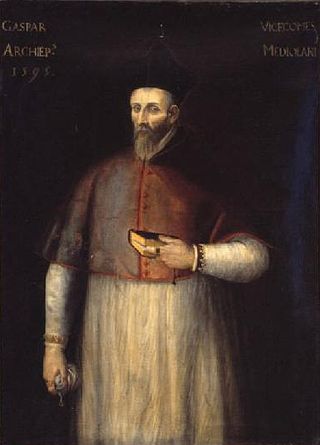
Lake Como, also known as Lario, is a lake of glacial origin in Lombardy, Italy.
The Salimbeni Prize is awarded by the Fondazione Salimbeni per le Arti Figurative of San Severino Marche to honour excellence in the writing of art history on an Italian subject. The Premio Salimbeni was established in 1983.

The Fondo Ambiente Italiano (FAI) is the National Trust of Italy.

Viareggio is a city and comune in northern Tuscany, Italy, on the coast of the Tyrrhenian Sea. With a population of over 62,000, it is the second largest city within the province of Lucca, after Lucca.

Pellegrino Tibaldi, also known as Pellegrino di Tibaldo de Pellegrini, was an Italian mannerist architect, sculptor, and mural painter.

Giovanni Luigi "Gianni" Brera was an Italian sports journalist and novelist. This is a description by himself: "My real name is Giovanni Luigi Brera. I was born on 8 September 1919 in San Zenone Po in the province of Pavia, and grew up like a wild man among woods, river banks and still waters. [...] I am a Padan from the banks and flood plains, the bush and the sandbanks. I soon realized I was a legitimate son of the Po".

The Villa del Balbianello is a villa in the comune of Lenno, a province in the north of the Lombardy region of Italy, overlooking Lake Como. It is located on the tip of the small wooded peninsula of Dosso d'Avedo on the western shore of the south-west branch of Lake Como, 1500 meters east from the Isola Comacina. The villa is famous for its elaborate terraced gardens.

Cabiate is a comune (municipality) in the Province of Como in the Italian region Lombardy, located about 20 kilometres (12 mi) north of Milan and about 20 kilometres (12 mi) southeast of Como.

Gravedona ed Uniti is a comune (municipality) in the Province of Como in the Italian region Lombardy, located about 80 kilometres (50 mi) north of Milan and about 40 kilometres (25 mi) northeast of Como.

Pietro Perna was an Italian printer, the leading printer of Late Renaissance Basel, the Erasmian crossroads between Italian Renaissance humanism and the Protestant Reformation. His books promoted the Italian heretical thinkers at the origins of Socinianism and the theory of Tolerance. He was a major publisher of Protestant historians like Flacius Illyricus and David Chytraeus and promoted the ars historica treatises of the period, notably the 18 authores de historia in Artis Historicae Penus (1579).

Angelo Maria Durini was an Italian Cardinal of the Roman-Catholic Church.

The Villa d'Este, originally Villa del Garovo, is a Renaissance patrician residence in Cernobbio on the shores of Lake Como in northern Italy. Both the villa and the 25-acre (100,000 m2) park which surrounds it have undergone significant changes since their sixteenth-century origins as a summer residence for the Cardinal of Como. Nevertheless, visiting the garden in 1903 for Century Magazine, Edith Wharton found this to be ‘the only old garden on Como which keeps more than a fragment of its original architecture’, and noted that ‘though Queen Caroline anglicised part of the grounds, the main lines of the Renaissance garden still exist’. Since 1873, the complex has been a luxury hotel.

Gaspare Visconti was the Archbishop of Milan from 1584 to 1595.
Giuliano Briganti was an Italian art historian.

Giorgio Orelli was an Italian-speaking Swiss poet, writer and translator.

Enrico Crispolti was an Italian art critic, curator and art historian. From 1984 to 2005, he was professor of history of contemporary art at the Università degli Studi di Siena, and director of the school of specialisation in art history. He previously taught at the Accademia di Belle Arti in Rome (1966–1973) and at the Università degli Studi di Salerno (1973–1984). He was author of the catalogues raisonnés of the works of Enrico Baj, Lucio Fontana and Renato Guttuso. He died in Rome on 8 December 2018.

Count Luigi Renato Porro-Lambertenghi was an Italian nationalist, businessman, and politician. He was the son of politician and essayist Luigi Lambertenghi (1739–1813).
The old farmhouses of Brugherio were agricultural structures typical of the Po-Valley in Lombardy, which gave its name to the surrounding areas as well, roughly corresponding to fractional towns in which Brugherio was divided. The union of the various small rural municipalities in which the territory was fragmented gave birth in 1866 to the municipality of Brugherio. Some are still visible: Bindellera, Casecca, Cattoni, Comolli, Dorderio, Guzzina, Increa, Modesta, Moia, Occhiate, Pareana, San Cristoforo, Sant'Ambrogio, San Paolo and Torazza.

Sigismondo Boldoni was an Italian writer, philosopher, and physician. Boldoni was born in Bellano and died in Pavia from the plague shortly before his 33rd birthday. At the time of his death he held the principal chair in philosophy at the University of Pavia. His literary works included a description of the geography and history of Lake Como entitled Larius and the epic poem La caduta de' Longobardi. His letters of 1629 describing the advance of invading German armies in the region around Lake Como and the plague epidemic they brought in their wake were used by Manzoni as a source for his 1827 novel I Promessi Sposi.

The Arese are a prominent family of the Milanese nobility.


















